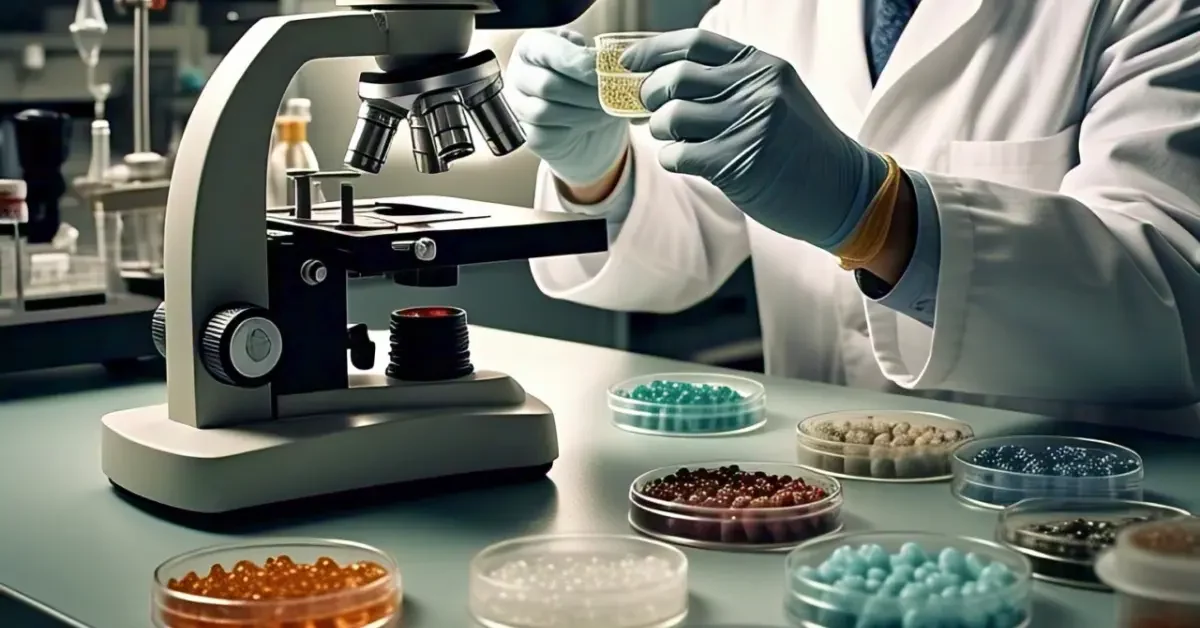You may be surprised to learn just how versatile and beneficial peptides can be for your health and wellness. These small chains of amino acids are playing an increasingly important role in various fields, such as skincare, bodybuilding, and overall health optimization. In this blog post, you’ll discover the different types of peptides, their unique functions, and how they can enhance your well-being. Dive into the peptide palette to unlock the potential benefits that these powerful molecules hold for you.
The Peptide Palette – Exploring the Diverse Range of Peptide Types and Benefits
Definition and Basic Structure
Peptides are short chains of amino acids linked together by peptide bonds. They play a vital role in various biological functions, acting as signaling molecules, hormones, and neurotransmitters. The basic structure of a peptide consists of a sequence of amino acids, typically ranging from 2 to 50 in length. Each amino acid in the chain is connected through an amide bond, formed during a biochemical reaction where the carboxyl group of one amino acid reacts with the amino group of another, releasing a molecule of water.
In essence, the arrangement of these amino acids determines the specific properties and functions of the peptide. Some peptides can be naturally occurring, while others may be synthesized in laboratories for therapeutic or research purposes. Understanding this fundamental structure will help you appreciate the diverse roles that peptides play in your body.
Types of Amino Acids
Amino acids, the building blocks of peptides, can be classified into two main categories: necessary and non-necessary amino acids. Essential amino acids must be obtained through your diet as your body cannot synthesize them independently, while non-necessary amino acids can be produced within your body. The characteristics and functions of these amino acids heavily influence the functionality of the peptides they form, leading to a vast diversity of peptide types.
- Essential amino acids include histidine, isoleucine, leucine, lysine, methionine, phenylalanine, threonine, tryptophan, and valine.
- Non-necessary amino acids include alanine, aspartic acid, cysteine, glutamic acid, and serine.
- Conditionally necessary amino acids include arginine, cysteine, glutamine, tyrosine, glycine, and proline.
- Peptides can be formed by combining various amino acids, resulting in distinct biological functions.
- This diversity in amino acid composition and arrangement contributes to the multitude of peptide types present in nature.
Below is a table displaying necessary and non-necessary amino acids along with their roles:
| Amino Acid Type | Examples |
|---|---|
| Essential Amino Acids | Histidine, Leucine, Lysine |
| Non-Essential Amino Acids | Alanine, Aspartic Acid, Glutamic Acid |
| Conditionally Essential Amino Acids | Arginine, Glutamine, Tyrosine |
| Amino Acid Functions | Protein synthesis, Hormonal regulation, Immune function |
| Diversity of Peptides | Hormones, Enzymes, Neurotransmitters |
In fact, understanding the types of amino acids helps you appreciate how distinct amino acid properties can lead to varying peptide functions. Distinct interactions between amino acids impact peptide folding, stability, and interaction with other biomolecules, driving unique biological effects.
- The combination of amino acids can further affect the solubility, charge, and reactivity of the peptides.
- Peptides derived from specific amino acids are often chosen for targeted therapies.
- Peptides can interact in different ways with receptors, influencing cellular signaling pathways.
- The study of amino acids can optimize peptide design for specific health benefits.
- This exploration can lead to innovations in therapeutic applications and enhance our understanding of peptide functionality.
Below, we will research into the fascinating process of peptide bond formation.
Peptide Bond Formation
Peptide bond formation occurs through a dehydration synthesis reaction, where the amino group of one amino acid combines with the carboxyl group of another. As a result, a molecule of water is released. This reaction is vital in constructing the peptide chain, and it generally requires the presence of enzymes called ribosomes, which facilitate the process during protein synthesis. The stability of the peptide bond allows proteins to maintain their structure, which is necessary for their functionality in biological systems.
This bond has unique properties, including partial double-bond characteristics, which restrict the rotation of the peptide bond. Such restrictions contribute to the overall three-dimensional structure of the resulting protein or peptide, hence influencing its biological activity. Understanding peptide bond formation is crucial for grasping how proteins and peptides are synthesized and how their structures correlate with their functions.
This insight into peptide bond formation can pave the way for various applications in biotechnology, including drug design and developing therapeutic peptides. By manipulating these bonds, you can create modified peptides with enhanced stability or targeted action.
Classification of Peptides
You might be surprised to learn that peptides can be classified in various ways, primarily based on their size and function. Understanding these classifications can help you appreciate the diverse roles peptides play in biological processes and their potential benefits in your health and wellness routines.
Based on Size
On the basis of size, peptides can be categorized into two main groups: oligopeptides and polypeptides. Oligopeptides typically consist of fewer than 20 amino acid residues, making them smaller and often easier for your body to absorb. These small peptides can play significant roles in signaling pathways, influencing various physiological functions, including hormone regulation and immune responses. Conversely, polypeptides are larger chains made up of 20 or more amino acids, and they can form complex structures that allow for a wider range of biological activities and interactions within your cells.
As you explore both oligopeptides and polypeptides, it’s important to recognize that their characteristics and effects can significantly vary. Oligopeptides often act more rapidly due to their simpler structure, while polypeptides may take longer to exert their effects but offer a greater scope of activity due to their more intricate formation.
Based on Function
Across the classification by function, peptides can be grouped into various categories, including signaling peptides, antimicrobial peptides, and transport peptides, among others. Signaling peptides play a vital role in cellular communication, which is crucial for processes like immune response and growth. Antimicrobial peptides contribute to your body’s defense against pathogens, showcasing their importance in maintaining health. Transport peptides, on the other hand, are responsible for the movement of various molecules across cell membranes, ensuring that crucial nutrients reach where they are needed most.
The diversity of peptides based on function highlights their crucial roles in numerous biological processes, from regulating metabolism to modulating the immune system. Each type serves a specific purpose, making it easier for you to target or incorporate specific peptides for your health needs. By exploring these classifications, you gain insight into the potential benefits and applications of peptides in your wellness journey.
Biological Roles of Peptides
To fully appreciate the diverse functions of peptides, it’s crucial to understand their biological roles in the human body. These small chains of amino acids are more than mere building blocks of proteins; they are dynamic molecules that play significant roles in various biochemical processes. From hormonal regulation to immune response and signaling, peptides influence many pathways that keep your body functioning optimally.
Hormonal Regulation
Along with being critical to cellular function, peptides act as hormones that regulate a multitude of physiological processes. They can influence your metabolism, growth, and even your mood. For example, peptide hormones like insulin and glucagon work together to regulate blood sugar levels, ensuring your body has a steady supply of energy and that your metabolic processes run smoothly. This interplay between peptides and hormonal systems demonstrates the far-reaching impact of these molecules.
Additionally, peptides such as oxytocin and vasopressin have significant effects on social behavior and water retention, respectively. The chemical signals emitted by these hormones can have a profound effect on your emotional well-being and physical health, showcasing how even small changes in peptide levels can lead to significant health outcomes.
Immune Response
Between the various systems in your body, peptides play a vital role in mounting an immune response. They act as signaling molecules that help to communicate between cells of the immune system, making it easier for your body to detect and respond to pathogens. Various antimicrobial peptides, for instance, serve as your body’s natural defense mechanism, offering protection against infections by disrupting the cell membranes of potential threats.
Moreover, these peptides also help to modulate inflammation and facilitate tissue repair. When your immune system is activated, peptides such as cytokines are secreted to recruit and activate immune cells, ensuring a quick and efficient response to any invaders. This harmony between peptides and the immune system is crucial for maintaining health and preventing disease.
Hormonal peptides are not limited to the immune system alone; they also interact with various other systems, offering a broader context of their importance. For example, certain peptides can assist in regulating inflammatory responses, which are vital for your overall health. By maintaining a balance between activation and resolution, these peptide systems promote healing while minimizing tissue damage, illustrating how intricate and crucial your body’s peptide network is.
Cell Signaling and Communication
Against the backdrop of cellular communication, peptides serve as vital messengers that allow for complex signaling between cells. They help relay signals from one cell to another, ensuring that each cell acts in concert with its neighbors to maintain overall homeostasis. For instance, peptides like growth factors play a critical role in tissue development and repair, guiding cells to perform specific functions at just the right time.
In addition, the effects of peptides extend beyond merely communicating between cells; they also impact how your body responds to internal and external stimuli. Signal transduction pathways often rely on peptide signals to bring about changes in gene expression and cellular behavior, ensuring that your body reacts appropriately to various conditions. This intricate landing of peptides in cell communication highlights the importance of understanding and harnessing their full potential.
Response pathways activated by peptides can influence various physiological processes, including growth, metabolism, and immune function. For example, when a peptide binds to a receptor on a cell surface, it triggers a cascade of events that can result in significant outcomes, such as the production of enzymes required for digestion or the activation of immune cells. By understanding these pathways, you can appreciate the profound impact peptides have on your overall health and wellness.
Applications of Peptides
Now that you have an understanding of the diverse types of peptides, it’s crucial to research into the various applications these powerful compounds offer. Peptides are being harnessed across multiple fields including therapeutics, cosmetics, and nutritional supplements, each serving to enhance your well-being and appearance in unique ways.
Therapeutic Uses
Behind the scenes, peptides are transforming modern medicine with their therapeutic applications. These chains of amino acids can act as signaling molecules in the body, influencing various biological responses. For instance, certain peptides are utilized in treatments for chronic conditions such as diabetes, cancer, and cardiovascular diseases. They can enhance your body’s natural ability to heal by promoting cellular repair and regeneration.
Moreover, peptides like insulin and growth hormone-releasing peptides have revolutionized the management of metabolic disorders and hormonal deficiencies. By mimicking the function of naturally occurring hormones, therapeutic peptides can help you achieve better health outcomes and improved quality of life.
Cosmetic Uses
The realm of cosmetics has also embraced peptides, leading to innovative products aimed at enhancing your skin’s health and appearance. Peptides in skincare are celebrated for their ability to penetrate the skin barrier and promote collagen production, effectively reducing the visibility of fine lines and wrinkles. By including peptide-rich formulations in your daily regimen, you can enjoy a more youthful glow and improved skin elasticity.
Consequently, many skincare brands are incorporating specific peptides that target various concerns such as hyperpigmentation, acne, and uneven skin tone. These formulations can provide anti-inflammatory benefits, soothe irritation, and promote an overall healthier complexion. When you invest in peptide-infused products, you’re not just addressing superficial concerns but supporting your skin’s inherent functions.
Nutritional Supplements
Repair is yet another key area where peptides show great promise, particularly in nutritional supplements. Peptides derived from proteins can greatly enhance your body’s nutritional profile by being more easily digestible and bioavailable than whole proteins. This means they can be absorbed more effectively, leading to optimal utilization of the amino acids your body needs for recovery and building muscle.
A growing market for peptide-based supplements highlights their role in sports nutrition and overall wellness. Whether you are looking to support muscle recovery after intense workouts or enhance your performance, incorporating peptides into your diet can provide a significant advantage. They offer a tailored approach to nutrition that aligns with your personal health goals and fitness regimen.
Peptide Synthesis and Production
Unlike other biomolecules, peptides exhibit unique structural diversity and functional specificity, which makes their synthesis a specialized area within biochemistry. The methods employed for peptide synthesis have evolved significantly, providing various approaches to meet the demands of research and therapeutic applications. Understanding these methods will enhance your comprehension of how peptides are produced and the potential advantages of each technique.
Solid-phase Peptide Synthesis
At the forefront of peptide synthesis is solid-phase peptide synthesis (SPPS), a method that allows for the efficient assembly of peptides on a solid support. The process begins with a resin to which the first amino acid is attached. Subsequent amino acids are then sequentially added in a series of reactions, allowing for the stepwise elongation of the peptide chain. This method has become popular due to its simplicity and ease of purification, as the unreacted materials and by-products can be easily washed away, leaving behind the desired product attached to the resin.
Moreover, SPPS provides greater control over the reaction conditions, facilitating the synthesis of longer and more complex peptides. You will find that this method is widely utilized in both research laboratories and commercial peptide production facilities, owing to its scalability and the ability to rapidly produce multiple peptides simultaneously via parallel synthesis techniques.
Liquid-phase Peptide Synthesis
Synthesis in a liquid phase can be a valuable alternative to solid-phase methods, especially for specific applications. In this approach, peptides are synthesized in a solution where reactants are continuously mixed, allowing for a more homogenous reaction environment. This method offers excellent yields for shorter peptides and is especially useful when working with glycoproteins or large, complex peptides that might be challenging to synthesize with solid-phase techniques.
With liquid-phase peptide synthesis, you have the flexibility to manipulate concentrations and reactant ratios dynamically, which can enhance the reaction’s efficiency. While this method may not always offer the purification advantages of SPPS, it still plays an important role in the broader context of peptide production when considering specific synthesis needs.
Recombinant DNA Technology
Peptide production can also leverage recombinant DNA technology, which allows researchers to harness the cellular machinery of organisms like bacteria or yeast to synthesize peptides. By cloning the gene responsible for producing a target peptide, you can induce the host organism to express the peptide, which is then harvested and purified. This method not only enables the production of longer and complex peptides but also incorporates post-translational modifications, further enhancing the peptide’s functionality.
Consequently, utilizing recombinant DNA technology can lead to higher yields and greater consistency in peptide production compared to traditional synthetic methods. It opens up avenues for creating more effective therapeutics by maintaining the natural conformation and activity of the peptides, ensuring they perform optimally in their intended biological roles.
Safety and Side Effects
Many individuals are eager to explore the benefits of peptides, yet it is crucial to consider safety and potential side effects associated with their use. While peptides are generally considered safe for most users, any supplementation can lead to adverse reactions in some cases. It is important for you to stay informed about these possible side effects and to approach peptide use with caution, particularly if you have pre-existing medical conditions or are taking other medications.
Common Side Effects
Safety is a primary concern when using peptides, as reactions can vary from person to person. Some common side effects you might experience include nausea, headaches, and fatigue. Additionally, some individuals could face allergic reactions or unwanted skin reactions at the injection site if the peptides are administered subcutaneously. Although these side effects are typically mild and temporary, it is crucial to monitor your body’s response and consult with a healthcare professional if you encounter persistent issues.
Safety Profiles of Popular Peptides
An in-depth understanding of the safety profiles of popular peptides can guide you in choosing the right type for your needs. Many well-researched peptides, such as BPC-157 and TB-500, have demonstrated favorable safety profiles in studies, with minimal side effects reported in both clinical trials and user experiences. However, it is imperative that you source your peptides from reputable suppliers to minimize the risk of contamination and ensure quality control.
Effects of different peptides can also vary significantly based on their composition and mechanism of action. It is beneficial for you to consult scientific literature or health professionals to gain insight into specific peptides before starting a regimen. This understanding helps you to make informed decisions tailored to your health goals and personal safety considerations.
Regulatory Considerations
Peptides are often classified in a gray area concerning regulation, depending on your country’s laws and standards. Many peptides are still undergoing research and may not have fully established regulatory status, which is crucial for ensuring their safety and efficacy. You should take the time to familiarize yourself with the local regulations surrounding peptide use, as this informs you not only about legal aspects but also about recommended practices for safe use.
Hence, staying informed about the regulatory environment for peptides enhances your awareness of what to expect in terms of quality and safety. Engaging with professionals or reliable resources can assist you in navigating this landscape and help ensure your peptide experience is safe and effective.
Future Trends in Peptide Research
After exploring the diverse range of peptide types and their unique benefits, it’s imperative to look ahead to the future of peptide research. The ongoing advancements promise to unlock new potential for peptides in therapeutic applications and beyond. As scientists continue to investigate the versatility of peptides, you may find the exciting possibilities ahead particularly intriguing in the realms of drug delivery systems, genomic studies, and personalized medicine.
Advances in Drug Delivery Systems
One of the most promising trends in peptide research is the development of innovative drug delivery systems that enhance the efficacy and specificity of peptide therapies. Researchers are working diligently to create targeted delivery methods that allow peptides to reach their intended sites of action more effectively. These advances include the use of nanocarriers, which encapsulate peptides and liberate them at predetermined times and locations within the body. As a result, you can anticipate therapies that offer sustained effects while minimizing side effects, ultimately leading to improved patient compliance.
Moreover, the integration of advanced biocompatible materials to formulate peptide-based delivery systems is opening up new horizons. With these advancements, you will see peptides being effectively paired with other therapeutic modalities, thereby amplifying their effects. This convergence of technology and peptide science may pave the way for more sophisticated medical treatments that are tailored to the individual needs of patients.
Integrating Peptides with Genomic and Proteomic Studies
With the rapid progression of genomic and proteomic technologies, peptide research is evolving to incorporate a more data-driven approach. By integrating peptide analysis with genomic and proteomic data, researchers can gain deeper insights into the biological roles of peptides within various cellular contexts. This synergy enhances your understanding of how peptides interact with proteins, genes, and biological pathways, allowing for more precise therapeutic targeting.
Research in this area is not only shedding light on the mechanisms of peptide function but also driving innovations in biomarker discovery and drug development. By leveraging the power of high-throughput sequencing and advanced bioinformatics, you will see a significant increase in the identification of peptides that can serve as potential therapeutic agents or diagnostic biomarkers. This collaboration between peptide chemistry and molecular biology will undoubtedly enrich the landscape of personalized medicine.
The Rise of Personalized Peptide Therapeutics
By tailoring peptide-based therapies to the specific needs of individuals, researchers are moving towards a future where personalized peptide therapeutics become the norm. This approach is made possible by advancements in technology, allowing for the mass customization of peptide sequences based on individual genetic profiles and health conditions. As a result, you can expect therapies that are not only safer but also more effective, as they will be designed to address the unique mechanisms underlying each patient’s disease state.
This shift towards personalization in peptide therapeutics holds the promise of transforming the treatment landscape, particularly in chronic diseases and cancer therapies. As healthcare continues to embrace personalized medicine, the focus on patient-specific treatments will allow healthcare professionals to optimize therapy based on your unique biological makeup. This means you can look forward to more effective treatments that cater to your individual needs and potentially transform the outcomes of various medical conditions.
Summing Up
Presently, you have examined into the vibrant world of peptides, exploring the varied types and the multitude of benefits they offer. From collagen-boosting peptides that enhance your skin’s elasticity to muscle-building varieties that aid in your fitness journey, the significance of these compounds cannot be overstated. Understanding the diverse peptide palette allows you to tailor your health and wellness strategies effectively, ensuring that you choose the right types that align with your personal goals and needs.
As you navigate through the available peptide options, consider how each type can play a role in your overall well-being. Whether you’re looking for improvements in skin health, recovery from workouts, or simply a boost in vitality, there’s likely a peptide that meets your specifications. By incorporating peptides into your routine, you can leverage their unique properties and embrace a holistic approach to health that aligns with your aspirations.




